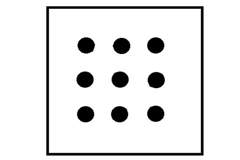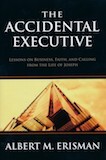How Creative are You?
Blog / Produced by The High Calling

A common test for creativity is the nine dot test. Examine the nine dots. Can you connect all the dots with only three straight lines that are continuous? In other words, can you connect all nine dots with three straights lines without lifting your pen? There can be no breaks: the lines need to be continuous.
Ever heard of thinking outside of the box? We assume we can’t draw outside of the box to find the solution to this problem. But, the instructions never say that. In fact, they never even mention the box. We tend to accept the constraints that are given to us. We narrow our focus to what we know and understand, not what is possible.
This kind of creative problem solving twists our brains. It takes time and a lot of effort. Is it really worth spending this much time and energy on creativity? If you are a writer or graphic designer, you probably answer that question with a resounding yes because creativity is so closely associated with the arts. However, we all need creative problem-solving skills. No matter what your work entails, more than likely it involves solving problems at one time or another. For some of us, solving problems is an everyday occurrence.
In their book, Developing Management Skills, Whetten and Cameron talk about conceptual blocks. These are obstacles that get in our way of thinking creatively. For instance, it’s been discovered that individuals with a formal education or years of experience tend to perform poorly in creative problem solving. Those with formal education have certain thinking boundaries and analytic frameworks that curb their creative process. Those with years of experience operate in a framework of past decisions and actions that produced the most success, but fail to consider alternatives. Such rigid boundaries restrict creative thinking.
Realizing we are prone to certain conceptual blocks helps us frame problem solving in a different way. As a consultant, I have to be really careful. I rely heavily on past my experience. But it’s easy to fall into a trap, so I must remember to be a problem solver. I’m certainly not going to ditch my experience. In fact, it’s a great asset. But I also need to question myself: Am I looking at a problem from a true creative prospective, or am I merely trying to connect all the dots within the constraints of the box?
In Groupthink, Irv Janis researches three disasters: Pearl Harbor, the Bay of Pigs, and the United States’ invasion of North Korea. He noticed distinct patterns in the leadership teams involved in all three events. These patterns created problem-solving blocks that resulted in detrimental decisions in each event. Groupthink occurs when certain attributes develop in decision-making teams, such as rationalization, shared stereotypes, or illusion of invulnerability. It’s more common than you think. As a consultant, it’s not unusual for me to witness groupthink in my work.
Janis lists a number of solutions for teams to avoid groupthink. It’s interesting to note that among his suggestions for combating it is to assign one person of a team the role of devil’s advocate, to challenge the group’s decisions. Yes, a devil’s advocate creates conflict. But in this case, the role of the devil’s advocate is not to attack people. The devil’s advocate does not criticize a person’s decision-making ability or identity. Rather, the devil’s advocate raises serious questions as to the validity of strategies being discussed. The role of the devil’s advocate is driven by shared values, not people.
All this to say: creative problem solving is more than coming up with a better mousetrap. It’s about making sure the best ideas are on the table. The lack of effective creative problem-solving may lead to bad decisions.
As a Christian, if I mean what I say-—that I strive to do all of my work as unto God—then I must endeavor to be creative. If it means it takes more time, so be it. If that means being humble and admitting there may be a better solution than my experience dictates, so be it. If it means being vulnerable and adding a devil’s advocate to decision-making, so be it. The goal isn’t to boast in what I know, but to help change the structures and systems around me for the better. With this in mind, creative problem solving is important and deserves our every effort for excellence—as unto the Lord.






